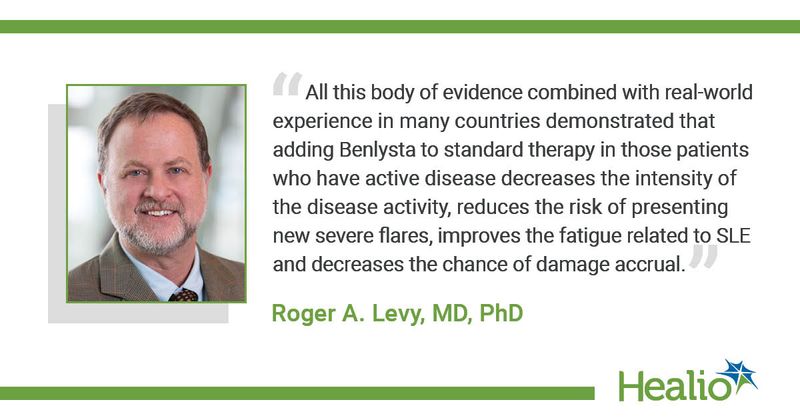A decade under Benlysta: Review touts how historic lupus drug continues to impact therapy
In the 10 years since its first FDA approval for systemic lupus erythematosus in 2011, belimumab has altered the “SLE treatment paradigm,” amassing a body of evidence establishing it as a disease-modifying therapy, according to a review article.
The review, published in Lupus, also states that several ongoing clinical trials are evaluating belimumab (Benlysta, GlaxoSmithKline) in pregnancy outcomes and in co-administration with other biologics.

“The article spans from the discovery of the B-lymphocyte stimulating protein — BLyS — and how it led to the development of Benlysta, a recombinant immunoglobulin G1 lambda monoclonal antibody,” Roger A. Levy, MD, PhD, global medical expert for GlaxoSmithKline, and primary author of the review, told Healio Rheumatology.
According to Levy and colleagues, more than 7,200 patients with SLE have received the drug in clinical studies as of April, and more than 75 countries have approved its use in adults with SLE. In 2017, both the FDA and European Medicines Agency (EMA) approved a subcutaneous, self-injectable formulation of belimumab, and 2019 saw its use expanded to children aged 5 years and older in the United States, Europe and Japan.
In December 2020, the FDA approved belimumab as the first therapy authorized to treat adults with lupus nephritis.
The article recounts the various pivotal trials that have evaluated the drug, including the phase 1 and 2 trials in 2001 and 2003, as well as the phase 3 BLISS-52 and BLISS-76 studies, BLISS-SC, BLISS-NEA, and their long-term extensions. Also discussed are the Efficacy of Belimumab in Subjects of Black RACE (EMBRACE) study, which pooled results from the BLISS-52 and -75 trials, the BASE safety trial and the post hoc BLISS-LN study.
According to the published results of the BLISS-LN trial, 43% of patients who received Benlysta alongside standard therapy achieved Primary Efficacy Renal Response (PERR) at week 104, compared with 32.3% of those in the placebo group (OR = 1.55; 95% CI, 1.04-2.32). Further, more patients in the belimumab achieved key secondary and other efficacy endpoints than those who received a placebo.
“All this body of evidence combined with real-world experience in many countries demonstrated that adding Benlysta to standard therapy in those patients who have active disease decreases the intensity of the disease activity, reduces the risk of presenting new severe flares, improves the fatigue related to SLE and decreases the chance of damage accrual,” Levy said.
Looking toward the future, the review states that several studies have evaluated, and continue to evaluate, the use of belimumab in sequential treatment with a cycle of rituximab (Rituxan, Genentech).
One ongoing trial, BEAT-LUPUS, is an investigator-sponsored study examining the safety and efficacy of belimumab after rituximab treatment in patients with active SLE resistant to standard therapy. Meanwhile, the GlaxoSmithKline-sponsored BLISS-BELIEVE study is an ongoing phase 3 trial evaluating belimumab with a cycle of rituximab in adult patients with SLE, with the rationale of “controlling rising BLyS levels due to rituximab-mediated depletion of B cells,” Levy and colleagues wrote. Results of the BLISS-BELIEVE study are expected in the second half of 2021.
“By reflecting on the 10 years’ experience with belimumab, it becomes evident that Benlysta targets BLyS, an underlying cause of SLE,” Levy said. “It therefore can modify the disease because it targets a fundamental pathogenic mechanism of SLE, improves clinical and serologic disease activity, impacts key drivers of organ damage — ie, disease activity, severe flares and cumulative steroid exposure — across multiple organs, and can reduce progression in long-term organ damage.”
